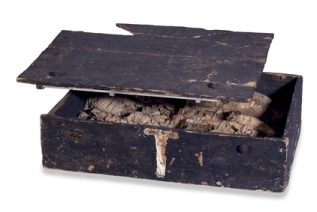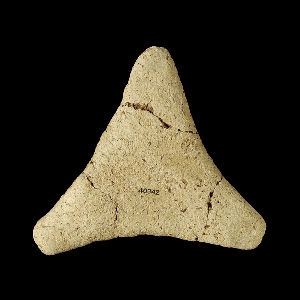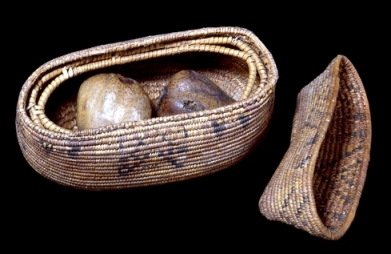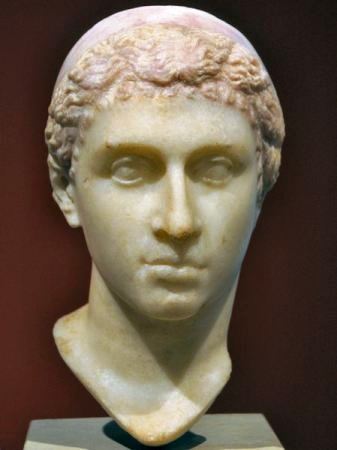Mother, goddess, harlot, sister, stateswoman, linguist, assassin, daughter, diplomat – Cleopatra, the last Queen of Egypt. Rarely has a woman been so revered and reviled at the same time, and even more rarely have so many half-truths been handed down through the centuries about one. Ask someone in the west what springs to mind when they think of Cleopatra and they will probably cite a scene from the 1960s film starring Elizabeth Taylor. Perhaps they will cite the scene in which she is presented, scantily clad, to the conquering Caesar rolled up in a carpet, or perhaps it will be the scene in which she enters Rome at the head of a parade of elephants with Caesar’s son, Caesarion, at her side. Both thrilling depictions of the Egyptian Queen, both more fiction than fact.
Last weekend we took the kids to Philadelphia to see the exhibit on Cleopatra that is touring the states. The exhibit is small, well presented and a wonderful exercise in mythbusting the stories that sully Cleopatra’s immortality. For instance, we learned that the Romans didn’t destroy every trace of the queen that they could find. Rather, a great deal of the city that Cleopatra knew and ruled from sunk in a series of natural disasters and now resides on the bottom of the Bay of Alexandria. This sunken city has been painstakingly excavated over the last couple of decades by French underwater archaeologist Franck Goddio with assistance from the Egyptian Supreme Council of Antiquities. To date, Goddio’s work has uncovered remains of Cleopatra’s royal palace, and two sunken cities – Heraklion and Canopus – along with hundreds of artifacts ranging from jewelery and coins to busts of Caesarion and colossal statues of Egyptian kings and queens that adorned the palace.
Of course, while I was walking through the exhibit, I couldn’t help but wonder what the Egyptians ate. The big problem is that although the ancient Egyptians were compulsive communicators leaving excellent records about so many things, there are no recipes. There are representations many things having to do with food, including the types of food people ate, Egypt’s bountiful harvests, activities at a bakery and a brewery, lots of descriptions of commodities paid as wages and several accounts of feasts – but few if any recipes. There are archaeological remains at the bottom of storage vessels, bowls and amphorae; models of servants preparing food and blessedly there are also funerary offerings, so there is some bona-fide evidence on to help us reconstruct the foods enjoyed by Egyptians.

I did find one resource that I think does a pretty good job of showing what food and drink they enjoyed in ancient Egypt, and that is a short but well done booklet by Hilary Wilson called Egyptian Food and Drink. Of course I also consulted Romer’s Ancient Lives which has a nice account of a feast that occurred in about 1204 BCE, but not a lot else about food at Deir-el-Medina. Lastly, I also checked out Herodotus’ Histories for some details on diets from the 5th Century BCE – written only 150 or so years before the Greeks began to rule Egypt.

As to vegetables, onions and garlic – both sweeter than those eaten today – were widely eaten and used in cuisine. Lettuce, cucumbers, squash and long gourds and melons of many types – including watermelons were also cultivated and eaten. With salt available – there is speculation that many vegetables could have been pickled to provide for ready-to-eat food year round. Lentils and chick peas, pigeon peas and yellow split peas were also enjoyed as well as a spinach-like plant both eaten and used to thicken broths and stews. Wilson states that fava beans were also widely enjoyed throughout a large swath of Egyptian history, but by the 5th Century BCE, we will see that Herodotus suggests that they had fallen out of favor at least in the priestly class.
The Egyptians had a large variety of fruits that they ate – including sycamore figs, true figs, dates, grapes, raisins and pomegranates which were introduced to Egypt in the Second Intermediate Period (1782-1570 BCE). Tigernuts were cultivated domestically, but almonds and walnuts were imported as were apples. Citrus was introduced as a cultivated fruit in the Greco-Roman period, but may have been imported earlier.

As far as meat is concerned, fish and wildfowl were the most commonly consumed. Cattle were also eaten, but much more rarely. Oxen were eaten only by the wealthy or on very special occasions. Pigs were eaten by working-class Egyptians on a fairly common basis as judged by heaps of remains at Armana. Wild game such as antelopes or gazelle were also enjoyed by the wealthy and noble of Egypt. A wide variety of birds were eaten with ducks and geese forming the bulk of those consumed. Wild birds such as egrets, storks, cranes and pigeons were also enjoyed. Eggs of ducks and geese were also eaten.
The milk of sheep and goats was also available in ancient times and fatty residues from a jar in a First Dynasty tomb have been identified as cheese. It is probable that yogurt was also eaten, although no firm evidence of its production or use has been found. Clarified butter may have been used, but grease was widely available from roasted animal fat as well. Several oils were also used including olive, castor, linseed and safflower plus a few unique to Egypt such as the oil from Egyptian balsam and the ben tree.
Herbs and spices cultivated in Egypt included flat parsley, cilantro, celery, rosemary, mint and sage. Cumin and coriander, fenugreek, and black mustard were also grown domestically. Cinnamon was brought in massive amounts from Sri Lanka (perhaps via Syria) and it’s possible that dill and fennel were imported from Western Asian and Central Asia as well.
In Romer’s account of the feast, based in part on ostraca Cairo 25504, shows that the tomb-builders of Deir-el-Medina were provided with a bounty of food to celebrate the Opet Festival because the Pharaoh was pleased with their work and progress. The ostraca details the 9000 loaves of bread and 9000 fish that were brought into the village as well as generous supplies of salt, beans and barley mash for beer. Ten oxen on the hoof were also provided for slaughter which would have provided everyone in the village with several fine meals of meat – and one not had every day by the tomb builders at this time. Romer also notes that there were vineyards near the village and that on feast days it was likely that grape wine was enjoyed as a special treat.
Although writing closest in time to Ptolemaic Egypt of all the references selected, Herodotus’ account offers only a little color and a few details to what has already been noted about the Egyptian diet. Still, it is important to note that the Greeks would have food and drink that suited their tastes imported or made, and this would not be recorded in Herotodus’s writings.
His account called the Egyptians the healthiest men of his acquaintance next to the Libyans and attributes this in part to their diet. Herodotus noted that they ate loves of “maize” (emmer wheat), brine cured fish, all manner of birds including ducks and quail and made wine out of barley (beer). He notes that meats were consumed after curing, boiling or roasting and that this varied by types. He describes the Egyptians living in the fenlands (delta area?) as eating lotus by pounding its heads and roots into flour and by making bread and by eating the flowers and seeds. These same people, he notes, also consume a lot of papyrus by baking the tender stems in a red-hot oven. Other bounties of the Nile seen on the tables of Egyptians in the city of Elephantine were crocodiles.
Herodotus also noted that the diets of the priestly class were different from those of ordinary Egyptians in both quantity and in type. He noted that every day, the priests had sacred bread baked for them and they have each great quantity of flesh of oxen and geese. The priests also drank wine of grapes, but were not permitted to eat fish. Moreover, he notes that beans were not consumed and that the priests would not even endure even to look upon them, thinking this to be an unclean kind of pulse. So it’s possible that beans had fallen out of favor amongst the priests by the 5th Century BCE.
So, what did Cleopatra eat? This far into the essay, I have to admit that I’m not sure. I can say that there is good evidence to suggest that she had a world of food and flavorings available to her and that a queen of one of the world’s wealthiest countries she exploited all of the opportunities that she had to try and taste foods from far flung shores. She also traveled – to Rome and Tarsus and many other places in between and would have had dishes that she became fond of on the road reconstructed for her at home.
There is some good scholarship out there to show us what the domestic production and consumption of food was like in ancient Egypt, but popularly available evidence is sparse in regards to the foods imported and how the trade routes and traders that got the good to Egypt’s already bountiful shores. There is scholarly work crying to be done on this subject that I hope some able soul undertakes someday. Ancient Egypt was powerful, rich and connected and yet there is little evidence of it even in the better popular references consulted. In Wilson’s book we are told that pomegranates are introduced in the 18th to 16th Centuries BCE and soon became cultivated, but there is no mention of where they come from (Western Asia) or how they were acquired. Romer, in Ancient Lives, does mention that although olive trees grew in Thebes, olive oil was also imported from Syria and Crete. Wilson also notes that wealthy citizens also imported certain types of beer from Syrian and Nubia.
We also need modern archaeological methods and tools to be brought to bear on the production, importation and consumption of food in ancient Egypt. As we saw at the Cleopatra exhibit, the Egyptian Supreme Council of Antiquities under the leadership of Zahi Hawass is questioning a lot of accepted knowledge about Cleopatra. The ongoing work of Franck Goddio is evidence of that as are the findings at Taposiris a city about 50 Km south and west of Alexandria. There, Hawass has uncovered many coins and artifacts from Cleopatra’s time, leading him to question whether she really committed suicide as history and Hollywood has shown us – or whether she escaped and fled to a nearby city. Whether a tantalizing possible discovery or showmanship to raise funds for further science – he is questioning the conclusions of earlier scholars and I wish him the best in his efforts for his bravery. God willing, he will continue to stand long-held conclusions on their heads. (Words by Laura Kelley. Photos of Cleopatra Bust from the Antiquities Museum in Berlin; other photos from the British Museum.)
*(I could find no reference of such an ostraca in either the Aberdeen, Ashmolean or British Museum collections. I will, however, continue looking and if I find a reference for the recipe, I will add to this post or post it anew.)

